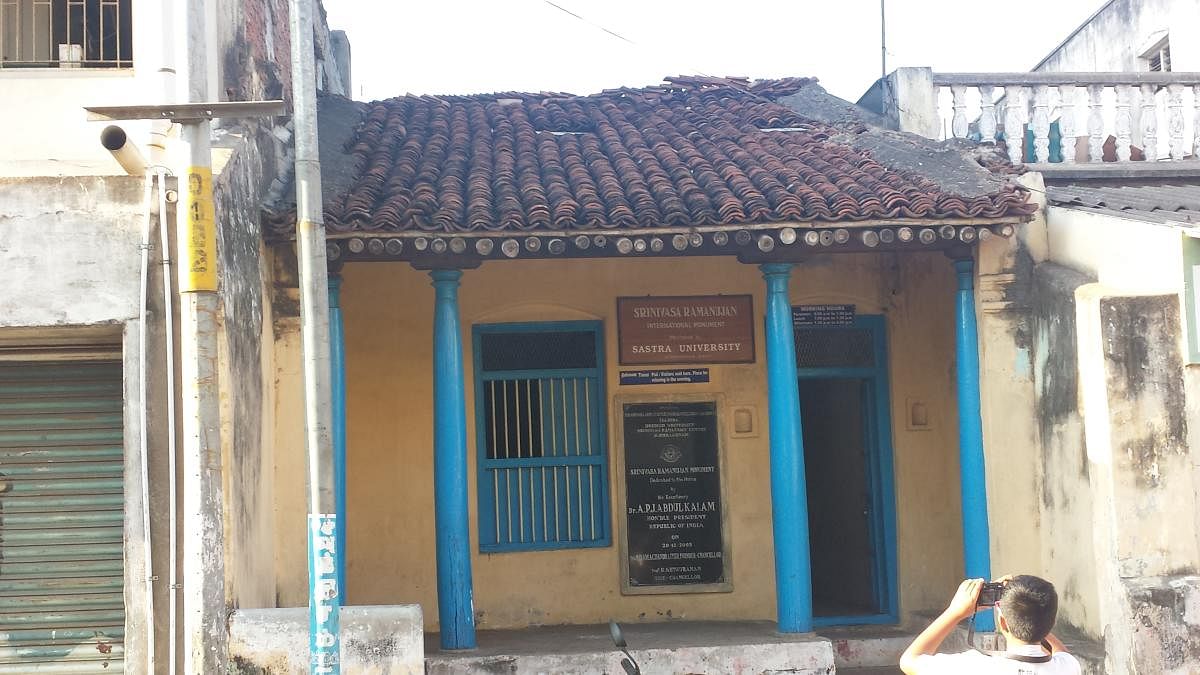
On the banks of River Cauvery, about 200 km from Chennai, in the district of Tanjavur, is the temple town of Kumbakonam.
Kumbakonam is a pilgrim’s delight famous for the navagraha temples — temples assigned to the nine planets, it is also an art connoisseur’s dream destination. Temples like Darasuram, a UNESCO heritage site, and the Ramaswamy Temple, have some of the finest architectural marvels.
One of the biggest temples, at the heart of Kumbakonam, is the Sarangapani Temple, dedicated to Lord Vishnu. This temple, another architectural marvel, overlooks a tiny lane bustling with honking rickshaws and motorbikes. This street sits proudly on the map — not because it leads to the temple, but because of a tiny house located here. This tiny house is the temple of worship in the world of Mathematics. This is the house of Shri Ramanujan, the man who knew infinity.
Kumbakonam is Ramanujan’s hometown. It is the place where he spent a considerable number of years. The small house on Sarangapani Sannidi Street is now an international monument — thanks to the former president of India, APJ Abdul Kalam. Till the year 2003, various occupants moved in and out of the house. On December 20, 2003, the then president, Abdul Kalam, inaugurated it as a monument and dedicated it to the nation. Ramanujan’s house in Kumbakonam is so inconspicuous that if you happen to walk by on this crowded street, you can easily miss it. Four blue, round pillars replete with mud-tiled roof - the regular middle-class house of yesteryears, stared at us. A neat rangoli drawn with powdered chalk outside the house instantly warmed us up.
A watchman greeted us and presented a visitor’s book to sign in. “Not many come here,” he said, when I asked him about tourists. “Only those who have read about it on the internet come. Maybe 10 to 15 visitors a day,” he said thoughtfully.
A bust of Ramnajun occupies the center of the house. Built typically like the old agraharam, this faces a small open courtyard. Next to the bust are some of Ramanujan’s works that are enclosed in glass cases. Also on display are the certificates he earned from the Town High School, and many other papers with complex mathematical equations and formulae. On the left is the bedroom. A large wooden cot occupies most of the room and a wide window overlooks the busy Sarangapani Street.
“They say that he used to look out of this window all the time,” the watchman quipped. A little board in blue reads what the watchman said.
A small door to the right of the central area leads to the kitchen. The kitchen is bare with just a small cooking area in a corner. The open courtyard opens out to the back of the house. The backyard has a well in a corner and a small gate that leads to a street on the other side. After a brief tour of the house, there is an unsettled feeling. For one, the house of the genius is just bare, except for a few of his works. Although impeccably clean and maintained by Shanmugha Arts, Science, Technology & Research Academy, popularly called Sastra University, the monument could do with something more. Perhaps, some visuals to re-create the genius’s short life?
On the way out of the house, we relaxed in the sit-out. It was soothing and remarkably cool even on a hot day.
“Who draws the rangoli?” I asked the watchman.
“An old lady in the neighbourhood,” he said, “she cleans up everyday and draws the rangoli for a salary”.
The rangoli was the only lively element of the house.
After dinner, we strolled down the street again to see the monument at night. As we approached the place, we couldn’t help but smile. A homeless man had curled up in the sit-out, blissfully snoring into the night, unaware that he was on the threshold of the temple of genius. And, I am sure, there are more such temples, unknown to us, as we sleepwalk through our lives.